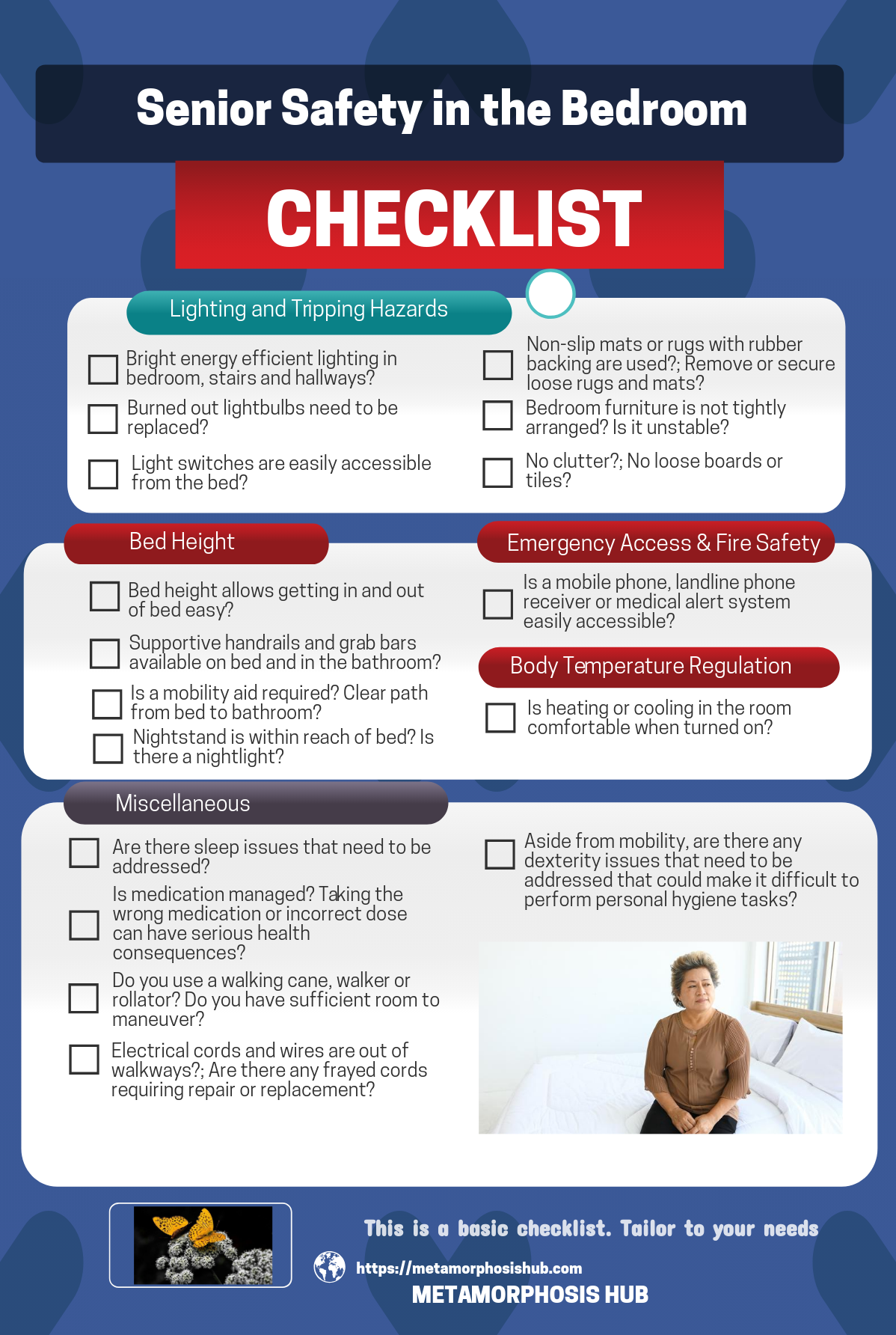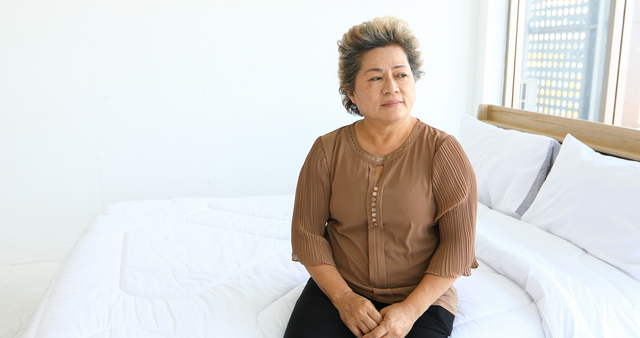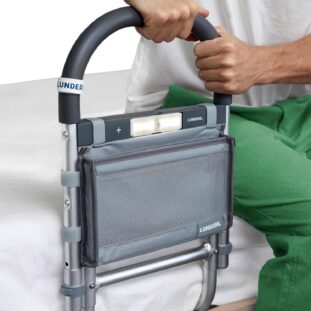Senior safety in the bedroom is extremely important because with aging, physical capabilities and health conditions may change, leading to an increased vulnerability especially to falls and accidents.
Due to these factors, the bedroom can pose significant risks. Falls can result in serious injuries, such as fractures or head trauma. Knowing these risks is a step away from deciding how to prevent them.
Risks and Senior Safety in the Bedroom
It is amazing how the bedroom is fraught with numerous risks for a senior, many of which are probably not on your radar! Fourteen risks are presented here.
14 Mobility Related Risks
Risk #1 – Lack of Risk Awareness Contributes to Reduced Senior Safety in the Bedroom

The biggest risk of all is not knowing, or the inability to recognize potential risks in the bedroom. This alone makes them more susceptible to accidents and falls.
Risk #2 – Falls
The most common and and significant risk for seniors in the bedroom are falls. Because of reduced muscle strength and reduced balance, mobility issues arise.
This can increase the chances of tripping or slipping, especially in the bedroom where there may be obstacles or uneven surfaces.
Risk #3 – Poor Lighting
Seniors might have difficulty navigating the bedroom in low light, increasing the chances of tripping or bumping into objects. Burned out lightbulbs that are not speedily replaced can create poor lighting conditions that can cause falls.
Risk #4 – Tripping Hazards
Clutter, loose rugs, cords, and tightly arranged furniture can create tripping hazards. Those seniors with limited vision or mobility are especially prone to these hazards which can be amplified by poor lighting conditions.
Risk #5 – Limited Mobility
Seniors might struggle with getting in and out of bed, especially if the bed height is inappropriate or there are no supportive handrails or mobility aids.
If the bed height is too high, then there is the added risk of straining to change sheets and adjust blankets which can cause falls or accidents
Risk #6 – Absence of Assistive Devices
Without proper assistive devices such as handrails, grab bars, or mobility aids, seniors might struggle to move around safely in the bedroom. This can greatly increase the risk of falls.
Risk #7 – Unstable Furniture
Because of a lack of mobility aids, seniors may try to use any piece of furniture for support while moving around. If this furniture is unstable or wobbly, it can collapse or break leading to falls or injuries.
Risk #8 – Bathroom Accessibility
If there is an attached bathroom to the bedroom, then the usual bathroom risks come into play. Read Why is Senior Safety in the Bathroom Important?
Wet and slippery floors and surfaces, absence of grab bars, low toilet seats and poor lighting in the bathroom can contribute to accidents.
Other Miscellaneous Risks – Bedroom Safety for the Elderly
Risk #9 – Body Temperature Regulation
Seniors, and especially the elderly are more susceptible to temperature fluctuations and therefore may have difficulty regulating their body temperature. This makes them more susceptible to extreme temperatures.
Inadequate heating or cooling in the bedroom can lead to discomfort or health complications.
Risk #10 – Mismanaging Medication
Because seniors frequently take multiple medications, coupled with confusion or memory issues, mistakes can easily arise in the management of medication. Taking the wrong medication or incorrect dosage can have serious health consequences.
Risk #11 – Emergency Access and Fire Safety
In case of a medical emergency, seniors need to have quick and easy access to means of communication. If they are unable to quickly reach a phone (mobile or landline) or medical alert system, the risk increases.

Fire hazards can exist in the bedroom, especially if there are electrical issues, flammable materials, or improperly used heating devices. Limited mobility might impede quick evacuation during a fire.
Risk #12 – Sleep Issues and Senior Safety in the Bedroom
Sleep issues among seniors can significantly impact their safety in the bedroom, creating potential hazards and increase the risk of accidents. Here are 8 ways in which sleep issues can affect senior safety in the bedroom and especially bedroom safety for elderly citizens:
Increased Risk of Falls: Sleep disturbances, such as insomnia or frequent waking during the night, can lead to grogginess and reduced alertness. Seniors may be more prone to falls when getting out of bed or moving around the bedroom in a state of drowsiness.
Reduced Mobility and Coordination: Sleep disorders can contribute to a decline in overall mobility and coordination. Seniors with impaired motor skills may struggle to navigate the bedroom safely, increasing the likelihood of tripping or stumbling.
Confusion and Disorientation: Sleep problems can exacerbate confusion and disorientation, especially if a senior wakes up during the night. Disoriented seniors may struggle to identify their surroundings, increasing the risk of accidents or injuries.
Medication Side Effects: Some sleep medications or medications prescribed for other conditions can have side effects that affect balance, coordination, or cognitive function. Seniors may experience these side effects during the night or upon waking, posing safety concerns.
Seniors with sleep problems may be more prone to medication errors, such as taking the wrong dose or forgetting to take medication altogether. This can impact their overall health and well-being.
Wandering Behavior: Sleep disorders, particularly those associated with conditions like dementia, can lead to wandering behavior during the night. Seniors may unintentionally wander into potentially hazardous areas of the bedroom or house.
Difficulty Getting In and Out of Bed: Seniors with sleep issues may find it challenging to get in and out of bed safely, especially if they experience stiffness, weakness, or joint pain. This difficulty can lead to falls or strain injuries.
Increased Vulnerability to Emergencies: Sleep-deprived seniors may have delayed reactions during emergencies, such as a fire or sudden medical issue. This vulnerability can compromise their ability to respond quickly and appropriately to urgent situations.
Impact on Mental Health: Persistent sleep issues can contribute to mental health challenges, including depression and anxiety. These conditions can further affect a senior’s overall well-being and ability to navigate their bedroom safely.
Poor sleep can affect overall health and increase the risk of accidents during the day.
To address sleep-related safety concerns, it is necessary to identify and treat the underlying sleep issues. This may involve consulting healthcare professionals, adjusting sleep environments, and implementing safety measures in the bedroom, such as adequate lighting, clear pathways, and assistive devices.
In addition, establishing a consistent bedtime routine and promoting good sleep hygiene can contribute to better sleep quality and overall safety for seniors in the bedroom.
Risk #13 – Personal Hygiene Challenges
Seniors with limited mobility or dexterity may find it challenging to perform personal hygiene tasks such as bathing, grooming, dressing or accessing necessary items, which could impact their well-being and safety.
Risk #14 – Failure to Make Adjustments to Senior Safety in the Bedroom Risks
This last risk is frequently overlooked, but could result in compound risks if not addressed. This is because as the senior needs change, adjustments must be made to avoid catastrophic consequences.
Preventing Falls in the Bedroom
To prevent falls in the bedroom requires mitigation of all these identified risks. This will involve modifications to the bedroom by improving lighting rearranging furniture, installing grab bars, and eliminating identified hazards.
Using a checklist will help generate a quick assessment to know where to begin making adjustments. Print off the checklist in this article and get started!
Conclusion – Senior Safety in the Bedroom
Having open communication can help to improve senior safety in the bedroom because it helps them understand their needs and also identify potential risks.
Finding solutions after this will be easier than if changes were just sprung upon previously independent seniors.
It is always a good idea to discuss with your healthcare professional who can provide additional guidance on risk mitigation not only for the bedroom but for the home and other high risk spaces – kitchen and bathroom.
Related Articles
- How to Prevent Seniors Falling – The Effects of Osteoporosis
- How to Maintain Independence – Prevent Causes of Falls in Seniors
- How to Prevent Falls in Seniors – Home Safety
- Why is Senior Safety in the Bathroom Important? – Facts
- How to Ensure Safety in the Kitchen – 11 Point Checklist
References
The Safe Living Guide—A Guide to Home Safety for Seniors https://www.canada.ca/en/public-health/services/health-promotion/aging-seniors/publications/publications-general-public/safe-living-guide-a-guide-home-safety-seniors.html


